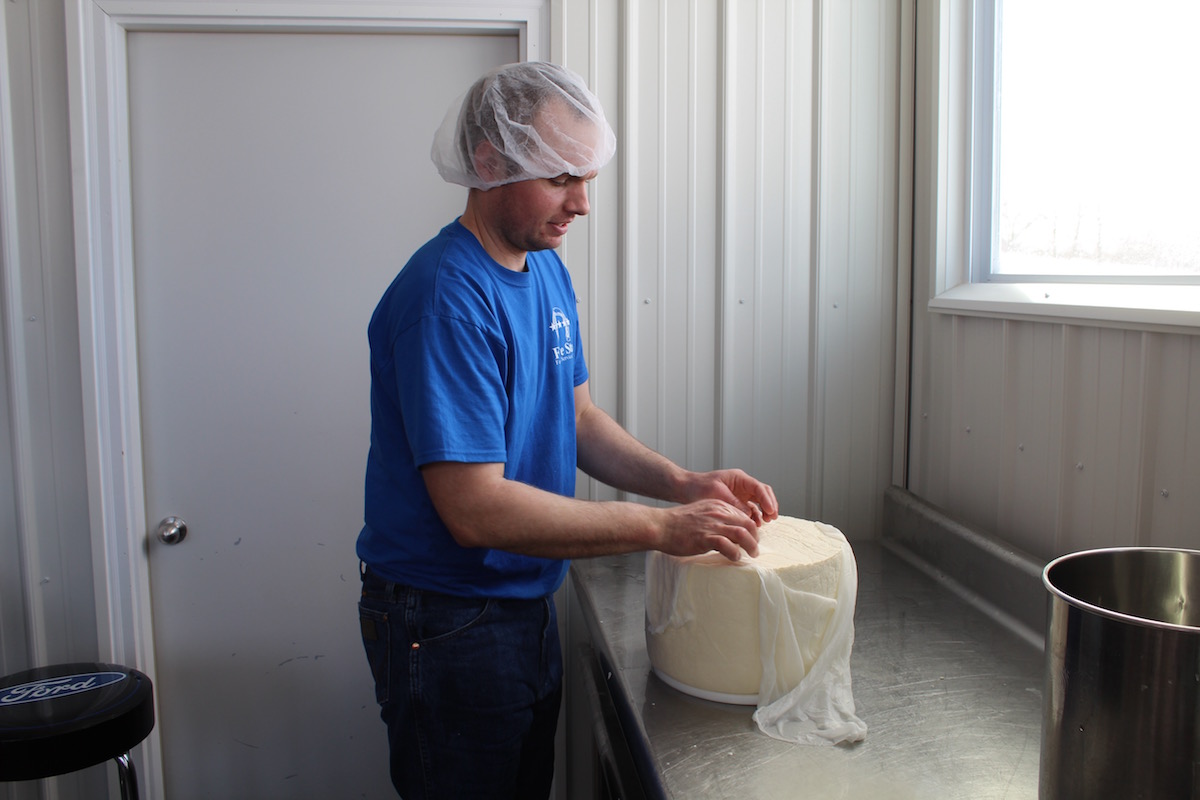
ROOTSTOWN, Ohio — Rebecca Oravets is elbow deep in a vat of curds and whey. She’s hand stirring what will soon become a batch of Gouda, trying to keep the curds from clumping together as they cook.
“You need to be gentle to the milk,” she said.
As she stirs, her husband, John Paul Oravets, or JP, washes out the bulk tank in the adjoining room. Their two children, 4-year-old John Paul, or Junior, and 2-year-old Myla wander around the cheese house. “Clifford the Big Red Dog” plays silently on a TV sitting atop a refrigerator. Country music croons quietly on the radio.
It’s cheesemaking day at Old Forge Dairy, in Portage County, where the Oravets family make aged cheese, from milk from their small herd of Ayrshire cows.
They have 11 cows and milk anywhere from six to 10 at any given time using a bucket milker. All the milk goes into the farm’s cheeses.
Everything about the Oravets’ operation is hands-on. From the way they built their barn and cheese house to the way they milk their cows and make the cheese. But it’s deliberate.
“There’s a reason for all the extra work,” Rebecca said. “It makes a difference in the taste.”

Biding time
The couple bought Rebecca’s parents farm in 2015 with the idea of making it their livelihood. Rebecca is the fifth generation to farm the land, but her great grandparents were the last ones to run it as a dairy farm.
“We worked for a year on deciding what to do. Our goal was to make our farm viable through dairy cows, whatever means that would be,” she said.
They’re both passionate about the land, but especially JP, Rebecca said. They believe small-scale dairy farming can be one of the best ways to build up the land and take care of it.
Before they bought the farm, they lived in Atwater, Ohio, on a couple acres. JP worked as a farrier. They had a dairy cow and made their own cheese and butter.
So making cheese was a natural way forward for them, although Rebecca said it was “probably the most difficult thing we could think of.” But it was the best way to get a return on their investment.
They spent a year getting the farm ready, converting the barn back to house dairy cattle. After that, they spent another year building the cheese house. They did all the work themselves as they could afford it, to avoid taking on extra debt.
“My dad is extremely handy,” Rebecca said. “And my husband and I learned how to do stuff that we didn’t know how to do.”
Old Forge Dairy made its first batch of cheese at the end of 2017.

All in good time
Most of their cheeses are aged for around a year, some a little more and some a little less. Making good cheese is part precise record keeping and part intuition, JP said.
Because their herd is so small, what they eat depends on the season, sometimes they’re on pasture and sometimes they’re in the barn eating hay. The milk changes accordingly, Rebecca said.
With many variables out of their control, the Oravetses control what they can. They focus on cow comfort, cleanliness and how the milk is handled.
That’s why Rebecca is stirring curds with her hands. Being gentle with the milk keeps the butter fat in the cheese. That, in turn, makes a creamier, tastier cheese and it keeps the fats from going to waste, she said.
They make cheese every few days, anywhere from 50 to 120 pounds at a time. Once the wheels are pressed and formed, they are aged on beechwood planks. Their clothbound cheddar is the most popular. It’s an English-style cheddar cheese. They also make Gouda, italiano, farmhouse and alpine.

Time well spent
Making cheese this way takes time. No cheese takes less than six hours per batch, and sometimes it can be up to 12 or 15 hours, although not straight through.
Add that to the time spent milking cows twice a day, spreading manure, making hay, planting and harvesting crops and raising two little children. They have two draft horses, Sampson and Abbey, who help them do farm work, and Junior has a Shetland pony, named Trigger. They also raise pigs.
It’s a busy life, and a hard one sometimes, but it’s a good one, they said.
They first sold their cheese at local shops and at farmers markets. The markets were great because they were able to get their name out there and get real-time feedback from customers about their products.
Then they started to get more wholesale customers, like Ohio City Provisions, in Cleveland; Michael Angelo’s Winery, in Richfield; and a distributor that puts their cheese in Heinen’s Grocery Store. That’s been a huge help and time-saver.
Read more about Ohio City Provisions: Cleveland butcher and grocer puts focus on local
After two full years, the plan to make dairy their livelihood is working. Anything they make gets invested back into the farm, but it’s viable. JP has all but quit shoeing horses.
“It’s one of the hardest times in your life to be starting a new business, when you have little kids,” Rebecca said. “But it makes them good kids. I do feel blessed and lucky that not many people get to have this with their family and have them grow up like this. I realized how unique this is.”
(Reporter Rachel Wagoner can be contacted at 800-837-3419 or rachel@farmanddairy.com.)

















What a WONDERFUL story for us here near Rootstown!
Have to get us some of their cheese!